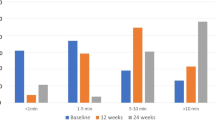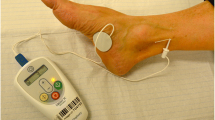Abstract
Purpose
Faecal incontinence is a disabling symptom which may be particularly difficult to treat. Recent studies showed that transcutaneous electrical posterior tibial nerve stimulation may improve faecal continence. In this study, we aimed to evaluate the effectiveness of this technique and tried to individualize predictive factors of success.
Methods
Twenty-four patients suffering from faecal incontinence were treated 20 min per day by applying transcutaneous electrical posterior tibial nerve stimulation for 3 months. A clinical evaluation was performed at the end of treatment, with Wexner’s score and analogical scales for symptoms. After 3 months, if the treatment was successful, patients were proposed to continue on the treatment. Predictive factors such as age, symptom duration, proctologic history, obstetrical history, ano-rectal manometric data and quality-of-life score were also analysed.
Results
At 3 months, 13 patients (54%) reported a significant symptomatic improvement with a significant modification in the Wexner’s score (14 vs 12, p < 0.025). At a median follow-up of 15 months, there were still 11 patients whose condition was improved.
Conclusion
This study shows encouraging mid-term results, and even if further randomized studies are necessary, transcutaneous electrical posterior tibial nerve stimulation may be a new and easy-to-use therapeutic option to treat faecal incontinence.
Similar content being viewed by others
References
Ganio E, Luc AR, Clerico G, Trompetto M (2001) Sacral nerve stimulation for treatment of fecal incontinence: a novel approach for intractable fecal incontinence. Dis Colon Rectum 44:619–631
Leroi AM, Parc Y, Lehur PA et al (2005) Efficacy of sacral nerve stimulation for fecal incontinence. Results of a multicenter double-blind crossover study. Ann Surg 242:662–669
Faucheron JL, Bost R, Duffournet V, Dupuy S, Cardin N, Bonaz B (2006) Sacral neuromodulation in the treatment of severe anal incontinence. Forty consecutive cases treated in one institution. Gastroenterol Clin Biol 30:669–672
Muñoz-Duyos A, Navarro-Luna A, Brosa M, Pando JA, Sitges-Serra A, Marco-Molina C (2008) Clinical and cost effectiveness of sacral nerve stimulation for faecal incontinence. Br J Surg 95:1037–43
Vitton V, Abysique A, Gaige S, Leroi AM, Bouvier M (2008) Colonosphincteric electromyographic response to sacral root stimulation: evidence for a somatosympathetic reflex. Neurogastroenterol Motil 20:407–416
Queralto M, Portier G, Cabarrot PH, Bonnaud G, Chotard JP, Nadrigny M, Lazorthes F (2006) Preliminary results of peripheral transcutaneous neuromodulation in the treatment of idiopathic fecal incontinence. Int J Colorectal Dis 21:670–672
Vitton V, Damon H, Roman S, Nancey S, Flourie B, Mion F (2009) Transcutaneous posterior tibial nerve stimulation for fecal incontinence in inflammatory bowel disease patients: a therapeutic option? Inflamm Bowel Dis 15:402–405
Jorge JM, Wexner SD (1993) Etiology and management of fecal incontinence. Dis Colon Rectum 36:77–97
Slim K, Bousquet J, Kwiatkowski F, Lescure G, Pezet D, Chipponi J (1999) First validation of the french version of the Gastrointestinal Quality of Life Index (GIQLI). Gastroenterol Clin Biol 23:25–31
Eypasch E, Williams JI, Wood-Dauphinee S, Ure BM, Schmulling C, Neugebauer E, Troidl H (1995) Gastrointestinal Quality of Life Index: development, validation and application of a new instrument. Br J Surg 82:216–222
Eléouet M, Siproudhis L, Guillou N, Le Couedic J, Damon H, Bretagne JF (2008) Neurostimulation tibiale postérieure dans le traitement de l’incontinence anale sévère. Gastroenterol Clin Biol 32:A135
Van der Pal F, Van Balken MR, Heesakkers JP, Debruyne FM, Bemelmans BL (2006) Percutaneous tibial nerve stimulation in the treatment of refractory overactive bladder syndrome: is maintenance treatment necessary? BJU Int 97:547–550
Van Balken MR, Vergunst H, Bemelmans BLH (2006) Prognostic factors for successful percutaneous tibial nerve stimulation. Eur Urol 49:360–365
Musial F, Klosterhalfen S, Enck P (2007) Placebo responses. World J Gastroenterol 13:3425–3429
Beecher HK (1955) The powerful placebo. J Am Med Assoc 159:1602–1606
Thorsteinsson G, Stonnington HH, Stillwell GK et al (1978) The placebo effect of transcutaneous electrical stimulation. Pain 5:31–41
Author information
Authors and Affiliations
Corresponding author
Additional information
An erratum to this article can be found at http://dx.doi.org/10.1007/s00384-010-1008-4
Rights and permissions
About this article
Cite this article
Veronique, V., Henri, D., Sabine, R. et al. Transcutaneous electrical posterior tibial nerve stimulation for faecal incontinence: effects on symptoms and quality of life. Int J Colorectal Dis 25, 1017–1020 (2010). https://doi.org/10.1007/s00384-010-0962-1
Accepted:
Published:
Issue Date:
DOI: https://doi.org/10.1007/s00384-010-0962-1




